Impact of Climate Smart Agriculture (CSA) Practices on Cotton Production and Livelihood of Farmers in Punjab, Pakistan
Abstract
1. Introduction
2. Materials and Methods
2.1. Data Information and Salient Features of the Study Area
2.2. Financial Performance: Cost and Benefits
2.3. Econometric Model
3. Results and Discussion
3.1. Summary Statistics of Farm and Socio-Economic Characteristics
3.2. Level of Input Use by Cotton Farmers
3.3. Cost and Benefit Analysis of Cotton Production
3.4. Econometric Analysis
3.5. Why Some Farmers Adopt CSA While Other Did Not?
3.5.1. Advantages of CSA Practices and Technologies
3.5.2. Reasons for Adoption of CSA
3.5.3. Reasons for Not Adopting CSA
3.5.4. Ranking of Willingness to Adopt CSA by Conventional Cotton Farmers
3.5.5. Mix of CSA Adoption Practices and Technologies among Adopters
3.5.6. Major Findings of Focus Group Discussions (FGDs)
4. Conclusions
- One of the reason of poor cotton yield is the non-availability of certified seed at a wider scale as only 12 percent farmers are using certified seed. The government should make certain arrangements for the preparation and judicious distribution of certified cotton seed among farmers at their door step to promote CSA in cotton growing areas of Punjab. The progressive farmers can be taken on board for the production and distribution of certified seed in the vicinity at market price.
- The government of Punjab is providing 50 percent subsidy on agricultural implements to farmers and Agricultural Service Providers (ASPs). It is advised that bed planters and laser land leveler should be included in the list of subsidized implements. The provision of these implements should be prioritized in cotton growing and water scared areas of Punjab.
- Awareness campaign about benefits of CSA practices and technologies need to be launched through print and electronic media and apps on smart phones in cotton growing areas. The success stories need to be demonstrated and disseminated, showing all the necessary measures to be adopted for sustainable farming, using CSA. Government can establish farmer’s field school and give necessary training to farmers, NGOs representatives, local leaders and ASPs regarding the use of water-smart, energy-smart, carbon-smart and knowledge-smart practices and technologies of CSA.
- Another important reason of low adoption rate of CSA is limited access to farm services (e.g., greater availability of resources, easy access to credit, market and agricultural extension services). The low adoption rate of CSA calls for major reforms in agricultural development policies and strategies. Access to above stated farm services can be the major drivers for adoption of CSA, particularly for small and marginalized farmers. That will provide incentives for farmers to use CSA practices and technologies which would play a role in rural poverty reduction and modernization of agriculture.
- Over the time, advisory services on climate change, and CSA practices and technologies remained unsatisfactory. Because of this poor performance, cotton farmers in Pakistan are experiencing low productivity, poor resource use efficiency and excessive use of external inputs. Therefore, a need arises for enhancing the training opportunities for all stakeholders (agricultural extension agents, agricultural service providers, progressive farmers, community representatives and public and private water related agencies) about climate change, and CSA practices and technologies.
Author Contributions
Acknowledgments
Conflicts of Interest
Appendix A
| Variables | Study Area | |||
|---|---|---|---|---|
| Sahiwal (5L) | Khanewal (2R/10R) | |||
| Education (Average Schooling Years) | 6.5 | 5.5 | ||
| Participants (Number) | 27 | 30 | ||
| Average land holding size (Acre) | Majority of the farmers have less than 12 acres | Majority of the farmers have less than 12 acres | ||
| Soil quality/Land type | Fertile and good quality | Fertile and good quality | ||
| Land rent per year (PKR/acre) | 23,500 | 22,500 | ||
| Location of participants with respect to distributary | Head, Middle and Tail | Head, Middle and Tail | ||
| Groundwater quality | Fit to marginal fit | Fit to marginal fit and unfit at tail | ||
| Bore depth | 53.34 m | 57.91 m | ||
| Groundwater table level | 16.50 m | 19.80 m | ||
| Tubewells Type | Tractor operated and 3 electric tubewells | Tractor operated and 4–5 electric tubewells | ||
| Main crops | Wheat, maize and cotton | Wheat and cotton | ||
| Water course lining (percent) | 33 | 33 | ||
| Groundwater treatment methods | FYM, conjunctive use and Gypsum | FYM, conjunctive use and Gypsum | ||
| Canal water supply during Kharif (percent) | 37.5 | 30.5 | ||
| FGDs participants response (percent) | Yes | No | Yes | No |
| Conjunctives use | 76.5 | 23.5 | 81.5 | 19.5 |
| Groundwater market | 55.5 | 44.5 | 67.5 | 32.5 |
| Access to farm services (credit, extension, markets, farm market roads) | 62.5 | 37.5 | 58.5 | 41.5 |
| Have groundwater quality worsen over the time? | 72.5 | 27.5 | 75 | 25 |
| Have groundwater table level declined over the time table level? | 77 | 23 | 83 | 17 |
| Does poor quality groundwater worsen the head-tail equity problem? | 56.5 | 43.5 | 59.5 | 40.5 |
| Does your farm productivity decrease over the time due to said problems? | 92.5 | 7.5 | 95 | 5 |
| FGDs participants response (percent) | Yes | No | Yes | No |
| Does your cost of production increased over the time due to said problems? | 88.5 | 11.5 | 90.5 | 9.5 |
| Do you think temperature in your area increased over the time? | 74.5 | 25.5 | 79.5 | 20.5 |
| Do you think your area received less rain fall over the time? | 77.5 | 22.5 | 84.5 | 15.5 |
| Have your area received rain fall at the time of sowing and harvesting? | 45 | 55 | 40 | 60 |
| Have your area affected by climate change over the time? | 78 | 22 | 82 | 18 |
| Does climate change have negative impact on agriculture? | 86 | 14 | 88 | 12 |
| Does your farm income decrease over the time due to climate change? | 77 | 23 | 81 | 19 |
| Does you destroy your crop due to abrupt change in weather and insect pest attack? | 14 | 86 | 10 | 90 |
| Mitigation measures adopted by farmers at farm in response to declining groundwater table, limited canal water supply, increasing soil salinity and climate change | ||||
| Farmers aware about CSA | 57.5 | 42.5 | 52.5 | 47.5 |
| Have you practiced water-smart practices? | 76.5 | 24.5 | 78.5 | 21.5 |
| Have you practiced energy-smart practices? | 66 | 34 | 61 | 39 |
| Have you practiced carbon-smart practices? | 54 | 46 | 63 | 37 |
| Have you practiced knowledge-smart practices? | 58 | 42 | 50.5 | 49.5 |
| Have you practiced nutrient and weather-smart practices? | 8 | 92 | 5.5 | 94.5 |
| Does CSA reduce the use of external inputs? | 82 | 18 | 80 | 20 |
| Does CSA practices and technologies resilient to climatic variations? | 79 | 21 | 75 | 25 |
| Does CSA reduce the cost of production? | 54 | 46 | 52 | 48 |
| Does CSA increase the yield? | 77 | 23 | 79.5 | 21.5 |
| Does CSA decrease soil salinity and increasing groundwater table level? | 69 | 31 | 71 | 29 |
| Does you have Limited information about CSA | 18.5 | 81.5 | 23 | 77 |
| Does CSA availability is limited in your area? | 74 | 26 | 73 | 27 |
| How much your yield Increase due to CSA (percent)? | 22–30 | 18–25 | ||
References
- GOP. Agricultural Statistics of Pakistan 2016-17; Ministriy of Finance: Islamabad, Pakistan, 30 June 2007. Available online: http://www.finance.gov.pk/survey_1617.html (accessed on 7 November 2017).
- Waqas, A.; Hong, C.; Maroof, A.M.; Rana, R.M.; Saima, A.; Ali, A. Comparison of Organic Farming and Conventional Farming In the Punjab, Pakistan. Int. J. Sci. Eng. Res. 2017, 8, 29–38. [Google Scholar]
- Bank, C.W. Climate-Smart Agriculture in Pakistan. CSA Country Profiles for Asia Series. International Center for Tropical Agriculture (CIAT); The World Bank: Washington, DC, USA, 2017; 28p, Available online: http://hdl.handle.net/10568/83340 (accessed on 21 December 2017).
- Abid, M.; Ngaruiya, G.; Scheffran, J.; Zulfiqar, F. The role of social networks in agricultural adaptation to climate change: Implications for sustainable agriculture in Pakistan. Climate 2017, 5, 1–21. [Google Scholar] [CrossRef]
- Abid, M.; Scheffran, J.; Schneider, U.A.; Ashfaq, M. Farmers’ perceptions of and adaptation strategies to climate change and their determinants: The case of Punjab province, Pakistan. Earth Syst. Dyn. 2015, 6, 225–243. [Google Scholar] [CrossRef]
- Abid, M.; Schneider, U.A.; Scheffran, J. Adaptation to climate change and its impacts on food productivity and crop income: Perspectives of farmers in rural Pakistan. J. Rural Stud. 2016, 47, 254–266. [Google Scholar] [CrossRef]
- Khan, M.; Akram, N.; Husnain, M.I.U.; Haq Padda, I.U.; Qureshi, S.A. Poverty-environment nexus: Use of pesticide in cotton zone of Punjab, Pakistan. Int. J. Sustain. Dev. 2011, 4. [Google Scholar] [CrossRef]
- Wada, Y.; van Beek, L.P.H.; van Kempen, C.M.; Reckman, J.W.T.M.; Vasak, S.; Bierkens, M.F.P. Global depletion of groundwater resources. Geophys. Res. Lett. 2010, 37. [Google Scholar] [CrossRef]
- Watto, M.A.; Mugera, A.W. Irrigation water demand and implications for groundwater pricing in Pakistan. Water Policy 2015, 18, 565–585. [Google Scholar] [CrossRef]
- Punthakey, E.F.; Khan, M.R.; Niaz, R.; Muhammad Riaz, M.J.; Zakir, G.; Usman, M.; Amin, M.; Ahmad, R.N.; Culas, R.; Baig, I.A.; et al. Optimising Canal and Groundwater Management to Assist Water User Associations in Maximizing Crop Production and Managing Salinisation in Australia and Pakistan; Australian Centre for International Agricultural Research (ACIAR): Canberra, Australia, 2016; pp. 1–32. Available online: https://researchoutput.csu.edu.au/en/publications/optimising-canal-and-groundwater-management-to-assist-water-user (accessed on 23 August 2017).
- Qureshi, A.S.; McCornick, P.G.; Sarwar, A.; Sharma, B.R. Challenges and Prospects of Sustainable Groundwater Management in the Indus Basin, Pakistan. Water Resour. Manag. 2009, 24, 1551–1569. [Google Scholar] [CrossRef]
- Ali, A.; Erenstein, O. Assessing farmer use of climate change adaptation practices and impacts on food security and poverty in Pakistan. Clim. Risk Manag. 2017, 16, 183–194. [Google Scholar] [CrossRef]
- Makhdum, A.H.; Khan, H.N.; Ahmad, S. Reducing cotton footprints through implementation of better management practices in cotton production; a step towards better cotton initiative. In Proceedings of the Fifth Meeting of the Asian Cotton Research and Development Network, Lahore, Pakistan, 23–26 February 2011; pp. 1–18. Available online: https://www.icac.org/tis/regional_networks/asian_network/meeting_5/ (accessed on 4 January 2018).
- Watto, M.A.; Mugera, A.W. Econometric estimation of groundwater irrigation efficiency of cotton cultivation farms in Pakistan. J. Hydrol. Reg. Stud. 2015, 4, 193–211. [Google Scholar] [CrossRef]
- Zulfiqar, F.; Thapa, G.B. Is ‘Better cotton’ better than conventional cotton in terms of input use efficiency and financial performance? Land Use Policy 2015, 52, 136–143. [Google Scholar] [CrossRef]
- Zulfiqar, F.; Datta, A.; Thapa, G.B. Determinants and resource use efficiency of “better cotton”: An innovative cleaner production alternative. J. Clean. Prod. 2017, 166, 1372–1380. [Google Scholar] [CrossRef]
- Nazli, H.; Orden, D.; Sarker, R.; Meilke, K. Bt Cotton Adoption and Wellbeing of Farmers in Pakistan. In Proceedings of the International Association of Agricultural Economists (IAAE) Triennial Conference, Foz do Iguaçu, Brazil, 18–24 August 2012; pp. 1–26. Available online: ageconsearch.umn.edu/bitstream/126172/ (accessed on 3 February 2018).
- Raza, A.; Ahmad, M. Analysing the Impact of Climate Change on Cotton Productivity in Punjab and Sindh, Pakistan; Pakistan Institute of Development Economics (PIDE): Islamabad, Pakistan, 2015; p. 32. Available online: https://mpra.ub.uni-muenchen.de/72867/ (accessed on 29 January 2018).
- Zhu, T.; Ringler, C.; Iqbal, M.M.; Sulser, T.B.; Goheer, M.A. Climate Change Impacts and Adaptation Options for Water and Food in Pakistan: Scenario Analysis Using an Integrated Global Water and Food Projections Model. Water Int. 2013, 38, 651–669. [Google Scholar] [CrossRef]
- Iqbal, M.; Ahmad, M.; Mustafa, G. Impact of Farm Households’ Adaptation on Agricultural Productivity: Evidence from Different Agro-Ecologies of Pakistan. Climate Change Working Paper Series No. 5. MPRA Paper No. 72863. 2015, pp. 1–25. Available online: https://mpra.ub.uni-muenchen.de/id/eprint/72863 (accessed on 7 February 2018).
- Watto, M. Measuring Groundwater Irrigation Efficiency in Pakistan: A DEA Approach Using the Sub-vector and Slack-based Models. In Proceedings of the 57th Australian Agricultural and Resource Economics Society Annual Conference, Sydney, Australia, 5–8 February 2013; pp. 1–35. [Google Scholar]
- FAO. “Climate-Smart” Agriculture Policies, Practices and Financing for Food Security, Adaptation and Mitigation; Food and Agriculture Organization of the United State of America (FAO): Rome, Italy, 2010; pp. 1–49. Available online: http://www.fao.org/docrep/013/i1881e/i1881e00.htm (accessed on 21 December 2017).
- Khatri-Chhetri, A.; Aggarwal, P.K.; Joshi, P.K.; Vyas, S. Farmers’ prioritization of climate-smart agriculture (CSA) technologies. Agric. Syst. 2017, 151, 184–191. [Google Scholar] [CrossRef]
- Khatri-Chhetri, A.; Aryal, J.P.; Sapkota, T.B.; Khurana, R. Economic benefits of climate-smart agricultural practices to smallholder farmers in the Indo-Gangetic Plains of India. Curr. Sci. 2016, 110, 1251–1256. [Google Scholar] [CrossRef]
- Branca, G.; McCarthy, N.; Lipper, L.; Jolejole, M.C. Climate Smart Agriculture: A Synthesis of Empirical Evidence of Food Security and Mitigation Benefits from Improved Cropland; Food and Agriculture Organization of the United Nations (FAO): Rome, Italy, 2011; Available online: http://hdl.handle.net/10568/33460 (accessed on 3 February 2018).
- Jat, R.K.; Sapkota, T.B.; Singh, R.G.; Jat, M.L.; Kumar, M.; Gupta, R.K. Seven years of conservation agriculture in a rice—Wheat rotation of Eastern Gangetic Plains of South Asia: Yield trends and economic profitability. Field Crops Res. 2014, 164, 199–210. [Google Scholar] [CrossRef]
- Lipper, L.; Thornton, P.; Campbell, B.M.; Baedeker, T.; Braimoh, A.; Bwalya, M.; Caron, P.; Cattaneo, A.; Garrity, D.; Henry, K.; et al. Climate-smart agriculture for food security. Nat. Clim. Chang. 2014, 4, 1068–1072. [Google Scholar] [CrossRef]
- Sapkota, T.B.; Jat, M.L.; Aryal, J.P.; Jat, R.K.; Khatri-Chhetri, A. Climate change adaptation, greenhouse gas mitigation and economic profitability of conservation agriculture: Some examples from cereal systems of Indo-Gangetic Plains. J. Integr. Agric. 2015, 14, 1524–1533. [Google Scholar] [CrossRef]
- Challinor, A.J.; Watson, J.; Lobell, D.B.; Howden, S.M.; Smith, D.R.; Chhetri, N. A meta-analysis of crop yield under climate change and adaptation. Nat. Clim. Chang. 2014, 4, 287–291. [Google Scholar] [CrossRef]
- Easterling, W.; Aggarwal, P.; Batima, P.; Brander, K.; Erda, L.; Howden, M.; Kirilenko, A.; Morton, J.; Soussana, J.F.; Schmidhuber, J.; et al. Climate Change 2007: Impacts, Adaptation and Vulnerability; Cambridge University Press: Cambridge, UK, 2007; p. 40. Available online: http://www.ipcc.ch/publications_and_data/publications_ipcc_fourth_assessment_report (accessed on 6 February 2018).
- Finger, R.; Schmid, S.; Zurich, E. Modeling agricultural production risk and the adaptation to climate change. In 101st EAAE Seminar ‘Management of Climate Risks in Agriculture; Archive, M.P.R., Ed.; MPRA Paper No. 3943; Munich Personal RePEc Archive: Berlin, Germany, 2007; pp. 1–22. Available online: http://mpra.ub.uni-muenchen.de/3943/ (accessed on 6 February 2018).
- Hussain, M.; Ashfaq, M.; Ali, A.; Hassan, S.; Imran, M.A. An econometric analysis of bed-furrow irrigation for cultivatedwheat in irrigated areas of Punjab, Pakistan. Pak. J. Agric. Sci. 2017, 54, 467–474. [Google Scholar] [CrossRef]
- Xiong, W.; van der Velde, M.; Holman, I.P.; Balkovic, J.; Lin, E.; Skalský, R.; Porter, C.; Jones, J.; Khabarov, N.; Obersteiner, M. Can climate-smart agriculture reverse the recent slowing of rice yield growth in China? Agric. Ecosyst. Environ. 2014, 196, 125–136. [Google Scholar] [CrossRef]
- Sapkota, T.B.; Majumdar, K.; Jat, M.L.; Kumar, A.; Bishnoi, D.K.; McDonald, A.J.; Pampolino, M. Precision nutrient management in conservation agriculture based wheat production of Northwest India: Profitability, nutrient use efficiency and environmental footprint. Field Crops Res. 2014, 155, 233–244. [Google Scholar] [CrossRef]
- Naresh, R.K.; Singh, S.P.; Misra, A.K.; Tomar, S.S.; Kumar, P.; Kumar, V.; Kumar, S. Evaluation of the laser leveled land leveling technology on crop yield and water use productivity in Western Uttar Pradesh. Afr. J. Agric. Res. 2014, 9, 473–478. [Google Scholar] [CrossRef]
- Olayide, O.E.; Tetteh, I.K.; Popoola, L. Differential impacts of rainfall and irrigation on agricultural production in Nigeria: Any lessons for climate-smart agriculture? Agric. Water Manag. 2016, 178, 30–36. [Google Scholar] [CrossRef]
- Gathala, M.K.; Ladha, J.K.; Kumar, V.; Saharawat, Y.S.; Kumar, V.; Sharma, P.K.; Sharma, S.; Pathak, H. Tillage and crop establishment affects sustainability of South Asian rice-wheat system. Agron. J. 2011, 103. [Google Scholar] [CrossRef]
- Aryal, J.P.M.; Bhatia, M.; Jat, M.L.; Sidhu, H.S. Impacts of laser land leveling in rice–wheat systems of the north–western indo-gangetic plains of India. Food Secur. 2015, 7, 725–738. [Google Scholar] [CrossRef]
- Kumar, V.; Saharawat, Y.S.; Gathala, M.K.; Jat, A.S.; Singh, S.K.; Chaudhary, N.; Jat, M.L. Effect of different tillage and seeding methods on energy use efficiency and productivity of wheat in the Indo-Gangetic Plains. Field Crops Res. 2013, 142, 1–8. [Google Scholar] [CrossRef]
- Saharawat, Y.S.; Singh, B.; Malik, R.K.; Ladha, J.K.; Gathala, M.; Jat, M.L.; Kumar, V. Evaluation of alternative tillage and crop establishment methods in a rice–wheat rotation in North Western IGP. Field Crops Res. 2010, 116, 260–267. [Google Scholar] [CrossRef]
- Saharawat, Y.S.; Ladha, J.K.; Pathak, H.; Malik, R.K.; Gathala, M.; Gupta, R.K. Validation of InfoRCT model for resource conserving technologies in rice-wheat system on productivity, income and environment. J. Soil Sci. Environ. Manag. 2011, 3, 9–22. [Google Scholar] [CrossRef]
- Bakhsh, A.; Ashfaq, M.; Ali, A.; Hussain, M.; Rasool, G.; Haider, Z.; Faraz, R.H. Economic evaluation of different irrigation systems for wheat production in Rechna Doab, Pakistan. Pak. J. Agric. Sci. 2015, 52, 821–828. Available online: https://www.pakjas.com.pk/papers/2487.pdf (accessed on 19 September 2016).
- Latif, A.; Shakir, A.S.; Rashid, M.U. Appraisal of economic impact of zero tillage, laser land levelling and bed-furrow interventions in Punjab, Pakistan. Pak. J. Eng. Appl. Sci. 2013, 13, 65–81. [Google Scholar]
- Zulfiqar, F.; Thapa, G.B. Determinants and intensity of adoption of “better cotton” as an innovative cleaner production alternative. J. Clean. Prod. 2018, 172, 3468–3478. [Google Scholar] [CrossRef]
- Ashfaq, M.; Akram, M.; Baig, I.A.; Saghir, A. Impact of Groundwater on Wheat Production in District Jhang, Punjab, Pakistan. Sarhad J. Agric. 2009, 25, 121–125. [Google Scholar]
- Hussain, I.; Mudasser, M.; Hanjra, M.A.; Amrasinghe, U.; Molden, D. Improving wheat productivity in Pakistan: Econometric analysis using panel data from chaj in the upper Indus Basin. Water Int. 2004, 29, 189–200. [Google Scholar] [CrossRef]
- Shakoor, A.; Arshad, M.; Bakhsh, A.; Ahmed, R. GIS Based Assessment and Delineation og Groundwater Quality Zones and Its Impact on Agricultural Productivity. Pak. J. Agric. Sci. 2015, 52, 837–843. [Google Scholar]
- Basharat, M. Integration of Canal and Groundwater to Improve Cost and Quality Equity of Irrigation Water in a Canal Command. Ph.D. Thesis, University of Engineering and Technology Lahore, Lahore, Pakistan, 2012. [Google Scholar]
- Watto, M.A.; Mugera, A.W. Measuring production and irrigation efficiencies of rice farms: Evidence from the Punjab province, Pakistan. Asian Econ. J. 2014, 28, 301–322. [Google Scholar] [CrossRef]
- Javed, I.; Ghafoor, A.; Ali, A.; Imran, M.A.; Ashfaq, M. Margins and determinants of rice export from Pakistan to UAE market. Pak. J. Agric. Sci. 2015, 52, 557–563. [Google Scholar]
- Shahroudi, S.M. Estimation of food substance small-scale production function. Int. J. Food Sci. Technol. 2012, 2, 15–19. [Google Scholar]
- Hussain, M.; Farooq, M.; Shehzad, M.; Khan, M.B.; Wahid, A.; Shabir, G. Evaluating the performance of elite sunflower hybrids under saline conditions. Int. J. Agric. Biol. 2012, 14, 131–135. Available online: https://www.researchgate.net/publication/265414796 (accessed on 18 April 2018).
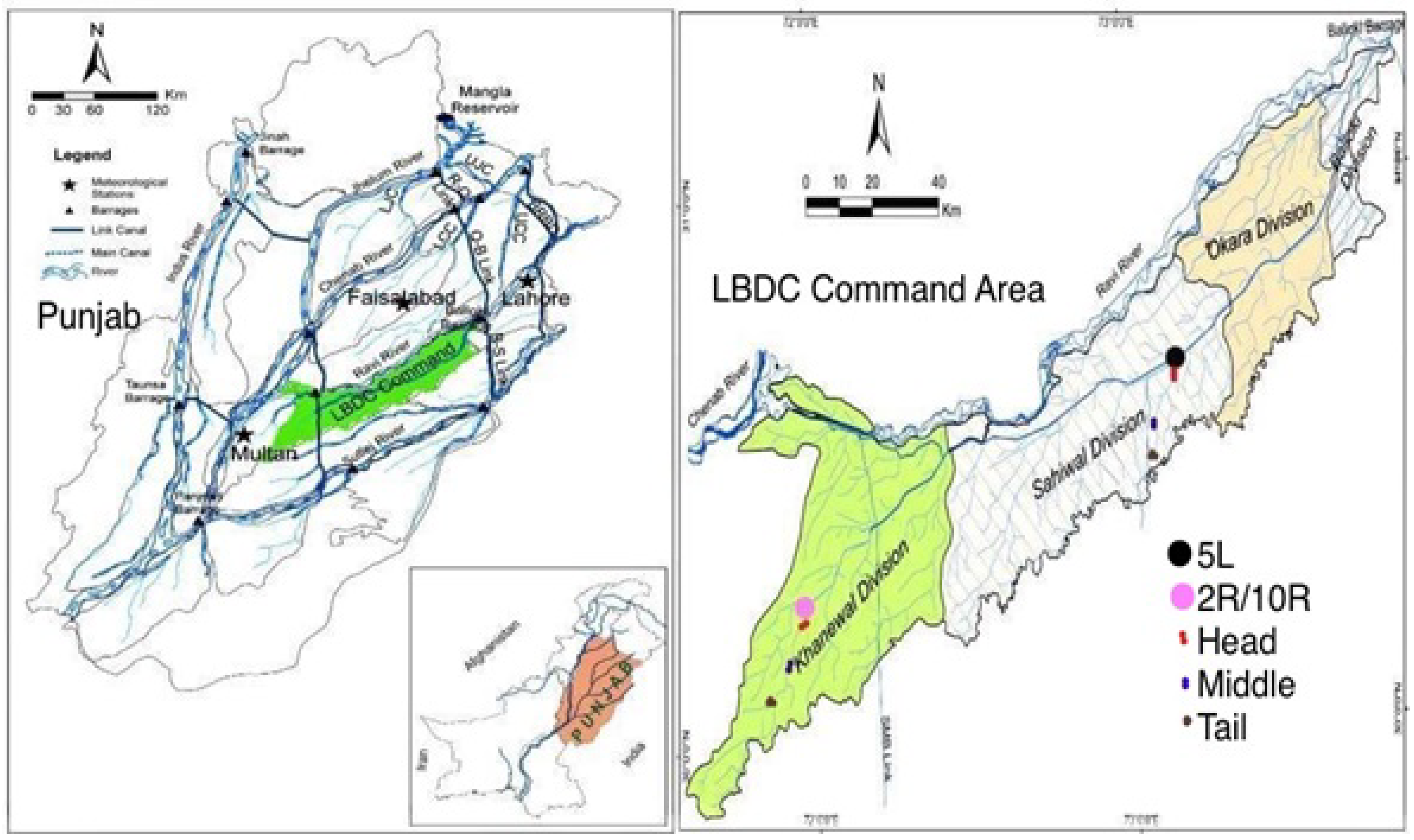
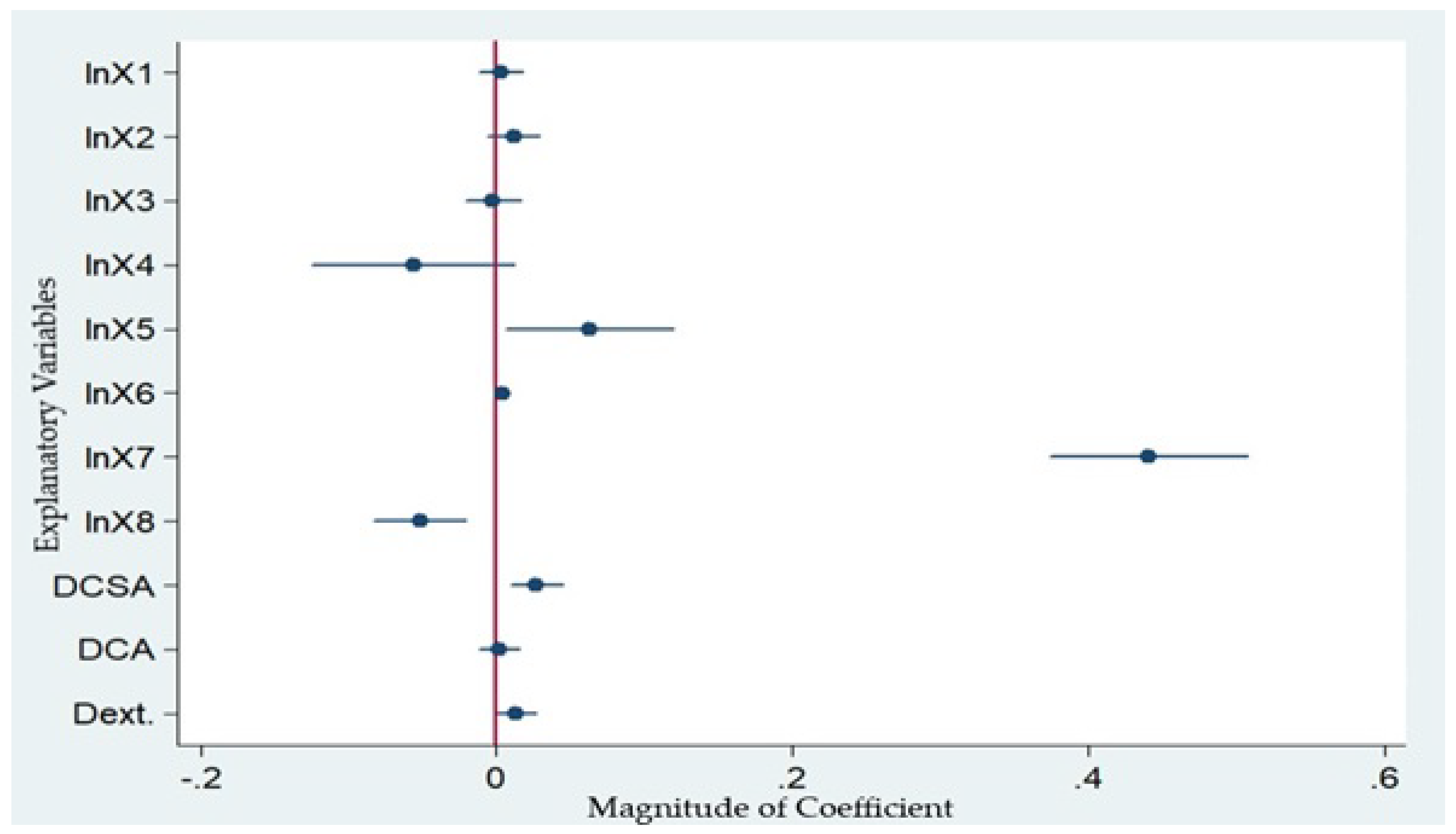
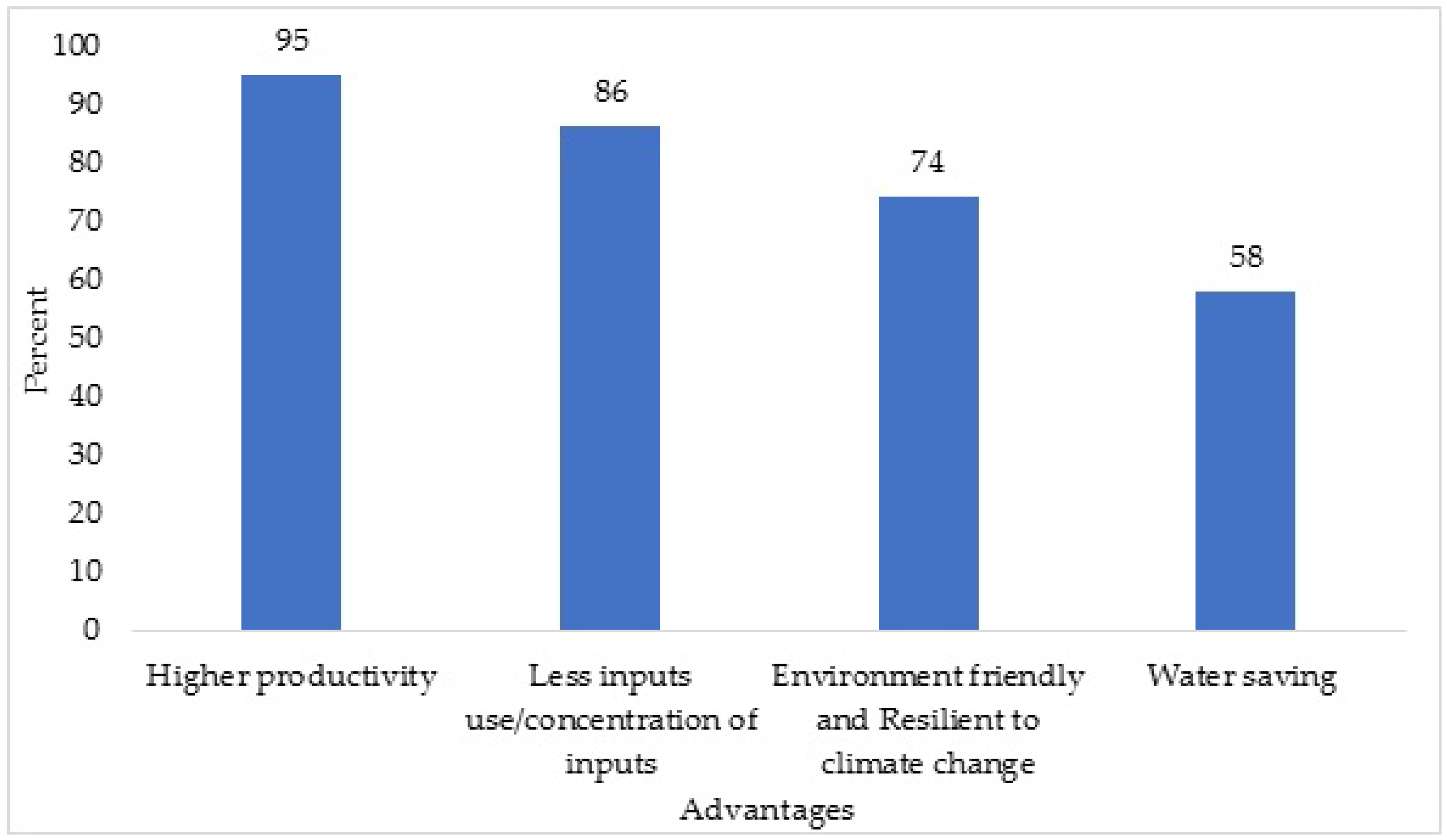
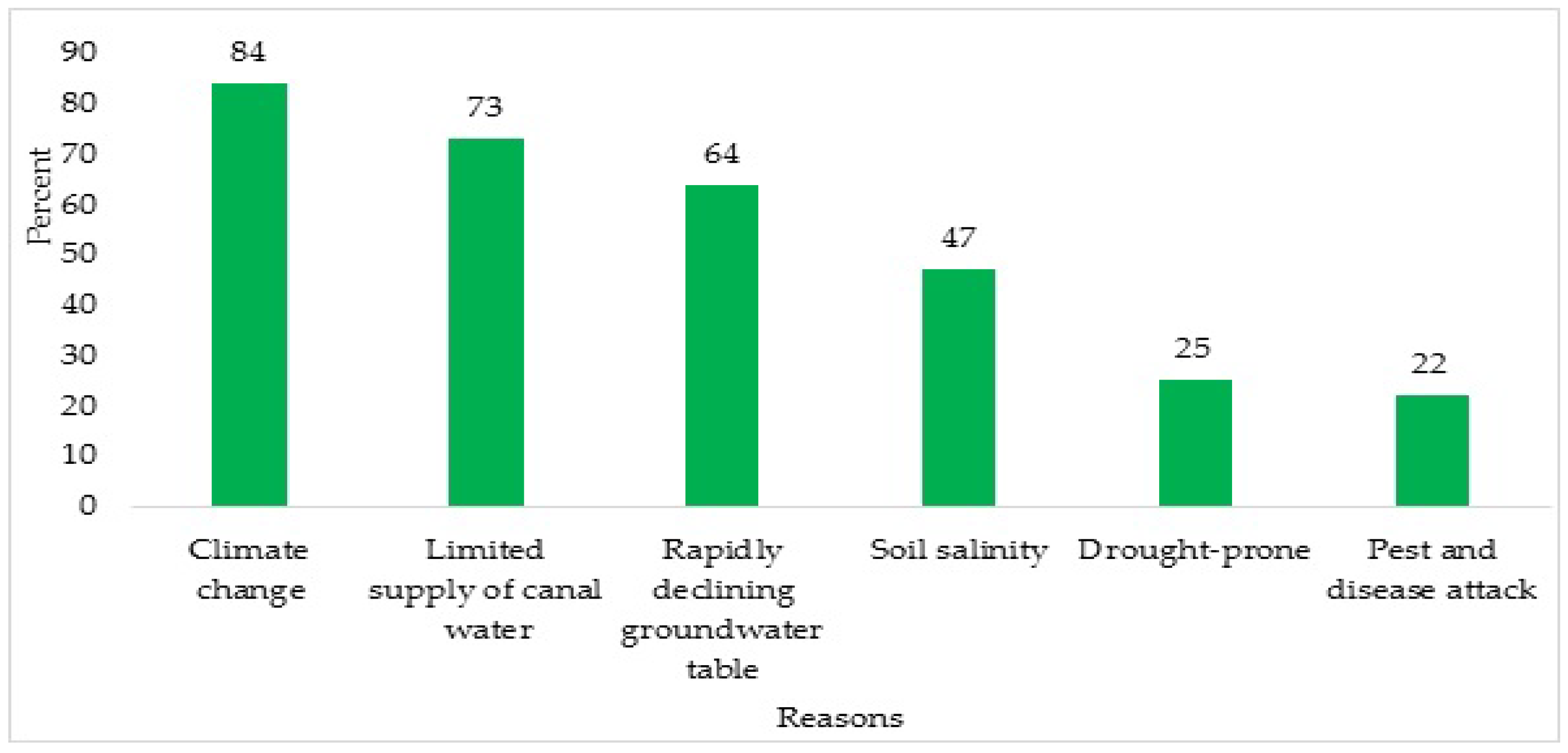
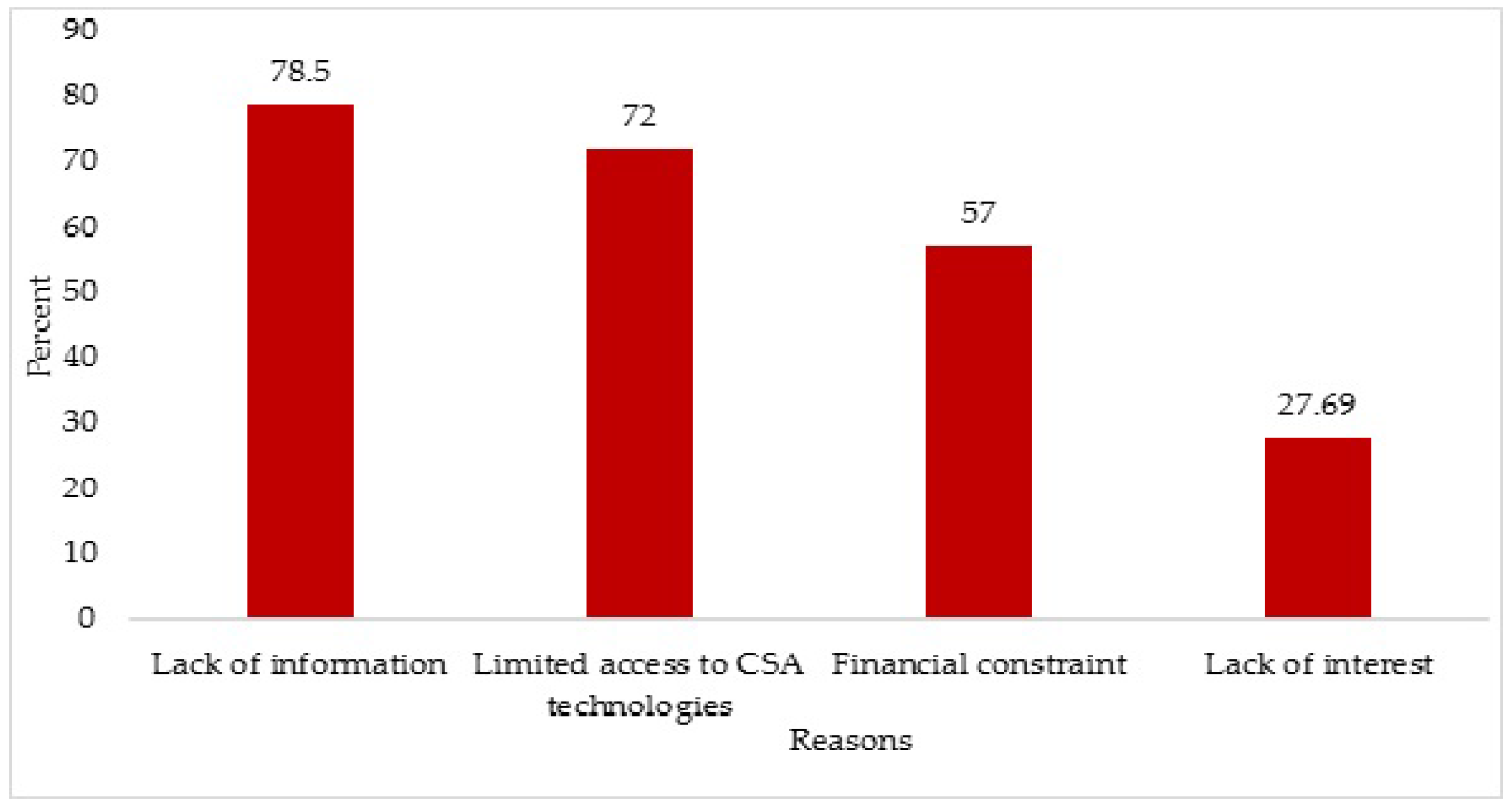
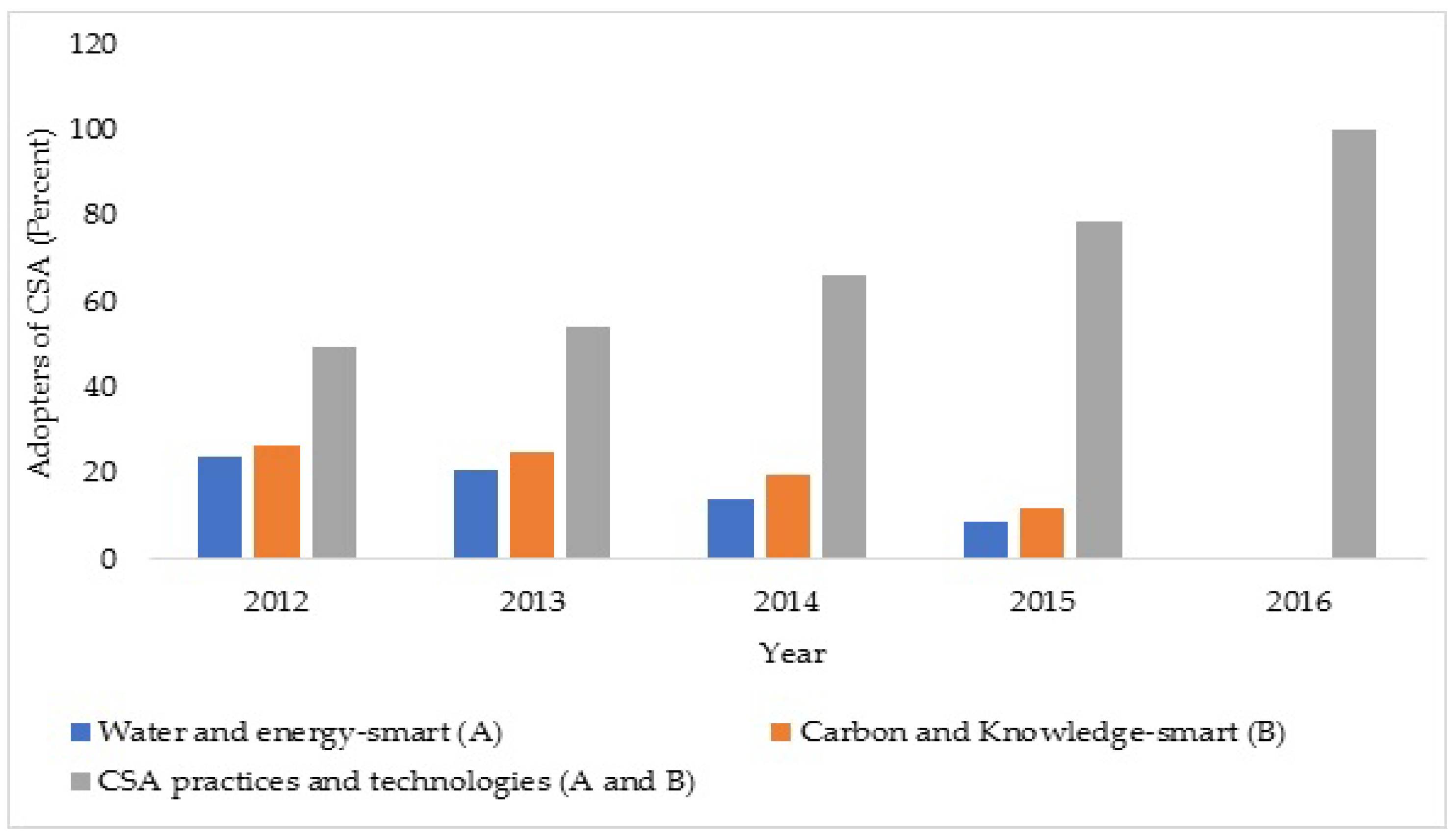
| Irrigation Divisions of LBDC Sampled | Sahiwal | Khanewal |
|---|---|---|
| Distributaries sampled | 5L | 2R/10R |
| Number of focus group discussion conducted | 3 | 3 |
| Number of participant in each focus group discussion | 25–30 | 25–30 |
| Number of watercourses sampled | 6 | 6 |
| Number of villages sampled | 6 | 10 |
| Number of respondents sampled | 48 | 150 |
| Variables | Cotton Farmers | |
|---|---|---|
| Adopters of CSA (N = 133) | Conventional (N = 65) | |
| Respondent age (years) | 45.72 ** | 42.558 ** |
| Farming experience (years) | 20.68 *** | 16.65 *** |
| Education (schooling years) | 6.34 *** | 5.49 *** |
| Family size (Nos.) | 8.85 | 8.28 |
| Operational land holding (acre) | 11.72 *** | 9.35 *** |
| Cotton area (acre) | 8.89 | 8.37 |
| Access to extension services (Yes = 1, No = 0) | 56.39 | 43.08 |
| Access to credit services (Yes = 1, No = 0) | 51.12 | 75.38 |
| Electrical conductivity (EC), used for groundwater quality (dS/m) | 1.12 | 1.17 |
| Power ownership (Own = 1, No = 0) | 45 | 29 |
| Family labor involved in farming (Nos.) | 1.23 *** | 2.26 *** |
| Inputs | Unit | Cotton Farmers | |
|---|---|---|---|
| Adopters of CSA (N = 133) | Conventional (N = 65) | ||
| 1. Land preparation | Nos. | 4.83 *** | 4.28 *** |
| Deep plough | Nos. | 0.24 | 0.00 |
| Rotavator | Nos. | 0.76 | 0.88 |
| Ploughing | Nos. | 2.13 | 2.40 |
| Planking | Nos. | 0.70 | 1.00 |
| Laser land leveling | Nos. | 1.00 | 0.00 |
| 2. Seed rate | Kgs | 7.69 *** | 9.88 *** |
| 3. Fertilizers (1 Bag = 50 kg) | Bags | 3.86 *** | 4.98 *** |
| DAP | Bags | 1.22 | 1.45 |
| Nitro-Phosphate | Bags | 0.09 | 0.24 |
| Urea | Bags | 2.25 | 2.80 |
| Potash | Bags | 0.24 | 0.15 |
| Other (NPK) | Bags | 0.06 | 0.34 |
| 4. Irrigation Water | m3 | 2486.32 *** | 3205.87 *** |
| Canal Water | m3 | 1375.6 | 1674.69 |
| Tubewell Water | m3 | 1110.72 | 1531.18 |
| 5. Time required/irrigation | Hours | 1.23 *** | 1.91 *** |
| 6. Intercultural operations | Nos. | 3.20 *** | 4.09 *** |
| Manual thinning and Hoeing | Nos. | 0.70 | 0.74 |
| Ridger | Nos. | 2.50 | 3.35 |
| 7. Farm Yard Manures (FYM) | Nos. of trolleys | 0.89 | 0.72 |
| 8. Gypsum | Bags | 0.77 *** | 0.54 *** |
| 9. Weedicides and insecticides | Nos. | 3.97 *** | 6.72 *** |
| Weedicides spray | Nos. | 0.86 | 1.00 |
| Insecticides spray | Nos. | 3.11 | 5.72 |
| Costs and Benefits | Cotton Farmers | |
|---|---|---|
| Adopters of CSA (N = 133) | Conventional (N = 65) | |
| Costs | ||
| Land Rent (for rented land) | 11,063.91 *** | 9734.62 *** |
| Land Preparation Cost | 4149.59 *** | 3186.54 *** |
| Seed and Sowing Cost | 5006.47 *** | 3910.23 *** |
| Irrigation Cost | 6620.03 *** | 8651.13 *** |
| Intercultural Operations Cost (thinning, hoeing and ridger) | 2480.68 *** | 3019.23 *** |
| Fertilizer Cost | 7697.89 *** | 9470.96 *** |
| FYM Cost | 632.71 | 507.69 |
| Chemical Cost (Gypsum, weedicides and insecticides) | 4175.64 *** | 6936.15 *** |
| Cotton picking cost (PKR/kg) | 9.19 *** | 8.28 *** |
| Total Cotton-Picking Cost (Yield*Cotton picking cost per kg) | 9249.62 *** | 7216.92 *** |
| Labor Cost (family and hired) | 10,597.80 *** | 8069.76 *** |
| Total Cost (TC) (rented land) | 61,674.33 * | 60,703.24 * |
| Total Cost (TC) (own land) | 50,610.42 | 50,968.62 |
| Benefits | ||
| Yield (kg/acre) | 1005.71 *** | 872.31 *** |
| Price (PKR/kg) | 72.01 | 72.02 |
| Total Revenue (TR) | 72,390.23 *** | 62,761.85 *** |
| Net Return (TR-TC) (rented land) | 10,715.90 *** | 2058.61 *** |
| Net Return (TR-TC) (own land) | 21,779.81 *** | 11,793.22 *** |
| BCR (rented land) | 1.18 *** | 1.04 *** |
| BCR (own land) | 1.44 *** | 1.24 *** |
| Explanatory Variables | Model | Robust Standard Errors |
|---|---|---|
| lnX1 | 0.00315 | 0.00745 |
| lnX2 | 0.0114 | 0.00893 |
| lnX3 | −0.00264 | 0.00955 |
| lnX4 | −0.0564 | 0.0347 |
| lnX5 | 0.0630 ** | 0.0287 |
| lnX6 | 0.00403 ** | 0.00187 |
| lnX7 | 0.441 *** | 0.0338 |
| lnX8 | −0.0518 *** | 0.0157 |
| DCSA | 0.0271 *** | 0.00901 |
| DCA | 0.00140 | 0.00676 |
| DExt. | 0.0134 * | 0.00684 |
| Constant | 3.019 *** | 0.207 |
| Observations | 198 | |
| R-squared | 0.715 |
| Adaptation Options of CSA | Percentage (%) | Rank |
|---|---|---|
| Knowledge-smart | 62 | I |
| Water-smart | 28 | II |
| Carbon-smart | 8 | III |
| Energy-smart | 2 | IV |
© 2018 by the authors. Licensee MDPI, Basel, Switzerland. This article is an open access article distributed under the terms and conditions of the Creative Commons Attribution (CC BY) license (http://creativecommons.org/licenses/by/4.0/).
Share and Cite
Imran, M.A.; Ali, A.; Ashfaq, M.; Hassan, S.; Culas, R.; Ma, C. Impact of Climate Smart Agriculture (CSA) Practices on Cotton Production and Livelihood of Farmers in Punjab, Pakistan. Sustainability 2018, 10, 2101. https://doi.org/10.3390/su10062101
Imran MA, Ali A, Ashfaq M, Hassan S, Culas R, Ma C. Impact of Climate Smart Agriculture (CSA) Practices on Cotton Production and Livelihood of Farmers in Punjab, Pakistan. Sustainability. 2018; 10(6):2101. https://doi.org/10.3390/su10062101
Chicago/Turabian StyleImran, Muhammad Ali, Asghar Ali, Muhammad Ashfaq, Sarfraz Hassan, Richard Culas, and Chunbo Ma. 2018. "Impact of Climate Smart Agriculture (CSA) Practices on Cotton Production and Livelihood of Farmers in Punjab, Pakistan" Sustainability 10, no. 6: 2101. https://doi.org/10.3390/su10062101
APA StyleImran, M. A., Ali, A., Ashfaq, M., Hassan, S., Culas, R., & Ma, C. (2018). Impact of Climate Smart Agriculture (CSA) Practices on Cotton Production and Livelihood of Farmers in Punjab, Pakistan. Sustainability, 10(6), 2101. https://doi.org/10.3390/su10062101






